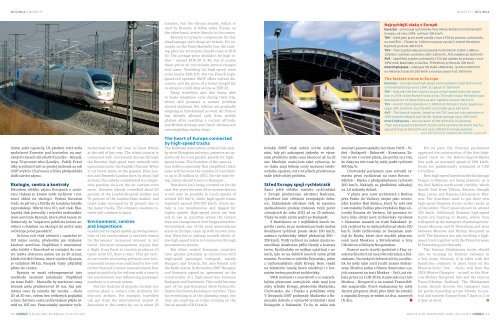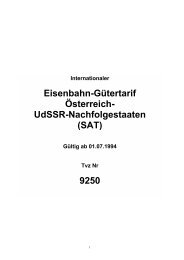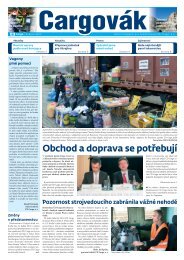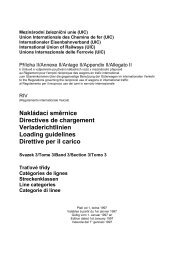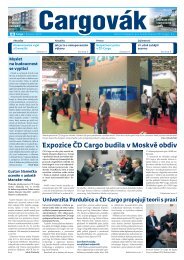Create successful ePaper yourself
Turn your PDF publications into a flip-book with our unique Google optimized e-Paper software.
NOVINKA / NOVELTY NOVELTY / NOVINKA<br />
liniím ještě upevnily. Už předtím totiž měla<br />
společnost Eurostar pod kontrolou na zmíněných<br />
tr<strong>as</strong>ách zhruba 60 (Londýn – Brusel),<br />
resp. 70 procent trhu (Londýn – Paříž). Právě<br />
díky zrychlení trati se prodej jízdenek za rok<br />
2007 zvýšil o 15 procent a fi rma předpokládá<br />
další nárůst zájmu.<br />
Ekologie, centra a kontroly<br />
Důvodem většího zájmu Evropanů o cestování<br />
vlakem je kromě vyšší rychlosti i rostoucí<br />
ohled na ekologii. Vedení Eurostar<br />
tvrdí, že při letu z Paříže do Londýna letadlo<br />
vyprodukuje 10krát více CO 2 než vlak. Ekologický<br />
tlak potvrdily i největší nízkonákladové<br />
aerolinie Ryanair, které před č<strong>as</strong>em informovaly,<br />
že “negativní publicita kolem aerolinií<br />
s ohledem na ekologii do určité míry<br />
ovlivňuje počet p<strong>as</strong>ažérů”.<br />
Určitou roli však sehrává i umístění letišť<br />
mimo centra, především pro nízkonákladové<br />
aerolinie. Například z mezinárodního<br />
letiště v Barceloně se cestující do centra<br />
města dostanou autem <strong>as</strong>i za 20 minut,<br />
kdežto letiště Girona, které využívá Ryanair,<br />
je vzdálené 90 km. Naopak vlaky přijíždějí<br />
přímo do centra.<br />
Ryanair se snaží vykompenzovat tuto<br />
nevýhodu lacinými letenkami. Například<br />
na tr<strong>as</strong>e Paříž – Marseille by startovací cena<br />
letenek měla představovat 10 eur. Ani průměrná<br />
cena by neměla být vysoká – okolo<br />
20 až 30 eur, ovšem bez veškerých poplatků<br />
a daní. Zatímco cesta rychlovlakem přijde téměž<br />
na 105 eur. Francouzský operátor rych-<br />
modernisation of rail lines in Great Britain<br />
at the end of l<strong>as</strong>t year. The island country is<br />
connected with continental Europe through<br />
the Eurostar high-speed train network with<br />
operations under the English Channel. When<br />
it cut travel times on the popular Paris-London<br />
and Brussels-London lines by about half<br />
an hour, the railway consolidated its competitive<br />
position vis-à-vis the air carriers even<br />
more. Eurostar already controlled about 60<br />
percent of the London-Brussels market and<br />
70 percent of the London-Paris market, and<br />
ticket sales incre<strong>as</strong>ed by 15 percent due to<br />
the f<strong>as</strong>ter tracks. The company <strong>as</strong>sumes interest<br />
will continue to grow.<br />
Environment, centres<br />
and inspections<br />
In addition to higher speeds, growing awareness<br />
of the environment is another re<strong>as</strong>on<br />
for Europeans’ incre<strong>as</strong>ed interest in rail<br />
travel. Eurostar management argues that<br />
a fl ight from Paris to London produces 10<br />
times more CO 2 than a train. That air carriers<br />
are under incre<strong>as</strong>ing pressure over environmental<br />
issues w<strong>as</strong> confi rmed by low-cost<br />
carrier Ryanair’s recent announcement that<br />
negative publicity for airlines with a view to<br />
the environment w<strong>as</strong> infl uencing p<strong>as</strong>senger<br />
numbers to a certain extent.<br />
But the location of airports outside city<br />
centres plays a certain role, primarily for<br />
low-cost airlines. For example, travellers<br />
can get from the international airport at<br />
Barcelona to the centre by car in about 20<br />
minutes, but the Girona airport, which is<br />
used by Ryanair, is 90 km away. Trains, on<br />
the other hand, arrive directly in the centre.<br />
Ryanair is trying to compensate for this<br />
disadvantage with cheap air tickets. For example,<br />
on the Paris-Marseille line the starting<br />
price for air tickets should come to EUR<br />
10. The average price shouldn’t be high either<br />
– around EUR 20 to 30, but of course<br />
these prices do not include service charges<br />
and taxes. Travelling by high-speed train<br />
costs nearly EUR 105. But the French highspeed<br />
rail operator SNCF offers certain discounts,<br />
and the price of a ticket bought far<br />
in advance could drop <strong>as</strong> low <strong>as</strong> EUR 22.<br />
Many travellers also like being able<br />
to make telephone calls during their trip,<br />
which still presents a certain problem<br />
aboard airplanes. But airlines are gradually<br />
adapting to this demand <strong>as</strong> well. Air France<br />
h<strong>as</strong> already allowed calls from mobile<br />
phones after reaching a certain altitude,<br />
and British Airways and Czech Airlines are<br />
contemplating similar steps.<br />
The heart of Europe connected<br />
by high-speed tracks<br />
The Railteam <strong>as</strong>sociation, created l<strong>as</strong>t year<br />
by most European railways, presents an opportunity<br />
for even greater growth for highspeed<br />
trains. The founders of the <strong>as</strong>sociation<br />
believe especially that simplifi ed ticket<br />
sales will incre<strong>as</strong>e the number of travellers<br />
to up to 25 million by 2012. For the time being,<br />
trains should travel to Budapest.<br />
Bratislava isn’t being counted on for the<br />
next few years because after modernisation<br />
it will only be possible to reach speeds of<br />
around 160 km/h, while high-speed trains<br />
regularly exceed 200-250 km/h. Czech terrain<br />
is too mountainous and rugged for<br />
higher speeds. High-speed trains are best<br />
put to use in countries where the terrain<br />
does not change much over longer stretches.<br />
Switzerland, one of the most mountainous<br />
states in Europe, came up with its own solution.<br />
Bern bet on railway tunnels which allow<br />
high-speed trains to travel even through<br />
mountainous terrain.<br />
But other central European countries<br />
have greater potential in connection with<br />
high-speed p<strong>as</strong>senger transport, mainly<br />
Hungary and Croatia, but also Poland and<br />
the Baltic states. In November 2007 Hungary<br />
and Romania signed an agreement on the<br />
construction of a high-speed line between<br />
Budapest and Bucharest. This could become<br />
part of the pan-European Paris-Vienna-Budapest-Bucharest-Konstanca<br />
corridor. Thus<br />
far everything is at the planning stage, but<br />
they are counting on trains running on the<br />
line at speeds of 300 km/h.<br />
lovlaků SNCF však nabízí určité zvýhodnění,<br />
kdy při zakoupení jízdenky ve výrazném<br />
předstihu může cena klesnout až na 22<br />
eur. Mnohým cestujícím také vyhovuje, že<br />
ve vlaku mají během cesty možnost telefonického<br />
spojení, což v letadlech představuje<br />
stále ještě určitý problém.<br />
Střed Evropy spojí rychlotratě<br />
<strong>Š</strong>anci ještě většího nárůstu rychlovlaků<br />
v Evropě představuje sdružení Railteam,<br />
vytvořené loni většinou evropských železnic.<br />
Zakladatelé sdružení věří, že zejména<br />
zjednodušení prodeje jízdenek zvýší počet<br />
cestujících do roku 2012 až na 25 milionů.<br />
Vlaky by měly zatím jezdit po Budapešť.<br />
S Bratislavou se v nejbližších letech nepočítá<br />
i proto, že po modernizaci bude možné<br />
dosáhnout rychlosti pouze okolo 160 km/h,<br />
zatímco rychlovlaky běžně překračují 200 –<br />
250 km/h. Vyšší rychlost na našem území neumožňuje<br />
dosáhnout příliš členitý a hornatý<br />
terén. Rychlovlaky se nejlépe uplatňují v zemích,<br />
kde se na delších úsecích terén příliš<br />
nemění. Po svém to vyřešilo <strong>Š</strong>výcarsko, jeden<br />
z nejhornatějších států Evropy. Bern vsadil<br />
na železniční tunely, které umožňují i v hornatém<br />
terénu používat rychlovlaky.<br />
Větší možnosti v souvislosti s co nejrychlejším<br />
přesunem cestujících však mají jiné<br />
státy střední Evropy, především Maďarsko,<br />
Chorvatsko, ale i Polsko a pobaltské státy.<br />
V listopadu 2007 podepsaly Maďarsko a Rumunsko<br />
dohodu o výstavbě rychlotrati mezi<br />
Budapeští a Bukureští. Ta by se měla stát<br />
součástí panevropského koridoru Paříž – Vídeň<br />
– Budapešť – Bukurešť – Konstanca. Zatím<br />
je vše v rovině plánů, ale počítá se s tím,<br />
že vlaky na této trati by měly jezdit rychlostí<br />
300 km/h.<br />
Chorvatský parlament z<strong>as</strong>e schválil výstavbu<br />
první rychlotrati na tr<strong>as</strong>e Botovo –<br />
Záhřeb – Rijeka s předpokládanou rychlostí<br />
200 km/h. Náklady se předběžně odhadují<br />
na 1,6 miliardy dolarů.<br />
V plánu jsou nové rychlotratě z Berlína<br />
přes Prahu do Varšavy, stejně jako severojižní<br />
koridor Rail Baltica, který by měl vést<br />
z estonského Tallinu přes lotyšskou Rigu a litovský<br />
Kaun<strong>as</strong> do Varšavy. Od prosince tohoto<br />
roku chtějí nové rychlovlaky vyrobené<br />
v Siemensu n<strong>as</strong>adit na tratě Rakušané. Jejich<br />
rychlost by se měla pohybovat okolo 230<br />
km/h. Další rychlovlaky ze Siemensu směřují<br />
do Ruska, které chce zrychlit přepravu<br />
osob mezi Moskvou a Petrohradem a brzy<br />
i Moskvou a Nižným Novgorodem.<br />
Rusové navíc stavějí společně s Finy vysokorychlostní<br />
trať mezi Petrohradem a Helsinkami.<br />
Na ruských železnicích by za několik<br />
let měly také začít jezdit známé šinkanzeny.<br />
Moskva jedná s fi rmou Sumitomo o jejich<br />
n<strong>as</strong>azení na trati Moskva – Soči, jež získala<br />
práva na LOH 2014, stejně jako na trati<br />
Moskva – Novgorod a na známé Transsibiřské<br />
magistrále. Právě šinkanzeny by měly<br />
zkrátit přepravu zboží přes Sibiř do střední<br />
a západní Evropy ze sedmi na dva, nanejvýš<br />
tři dny. ●<br />
Nejrychlejší vlaky v Evropě<br />
Eurostar – provozuje rychlovlaky mezi Velkou Británií a kontinentální<br />
Evropou od roku 1994, rychlost 300 km/h<br />
TAV – Itálie jako první země uvedla v roce 1978 do provozu rychlovlaky<br />
na trati Řím – Florencie. Z těchto souprav vychází i známé Pendolino.<br />
Rychlost je okolo 300 km/h.<br />
TGV – francouzské vlaky provozované na domácích tratích s délkou<br />
1500 km, rychlost v průměru 300–320 km/h, AGV zvládne až 360 km/h.<br />
AVE – španělský systém vycházející z TGV byl uveden do provozu v roce<br />
1992 mezi Madridem a Sevillou. Průměrná rychlost do 300 km/h.<br />
InterCityExpress – nástupce ICE vlaků v Německu, rychlost 160 km/h,<br />
na některých úsecích 200 km/h a na dvou úsecích až 300 km/h.<br />
The f<strong>as</strong>test trains in Europe<br />
Eurostar – h<strong>as</strong> operated high-speed trains between Great Britain and<br />
continental Europe since 1994; at speeds of 300 km/h<br />
TAV – Italy w<strong>as</strong> the fi rst country to put a high-speed train into operation<br />
in 1978 on the Rome-Florence line. The well-known Pendolino w<strong>as</strong><br />
developed out of these trains <strong>as</strong> well. Speed is around 300 km/h.<br />
TGV – French trains operate on 1,500 km of domestic track, Speed averages<br />
300-320 km/h, but the AGV can handle up to 360 km/h.<br />
AVE – The Spanish system, b<strong>as</strong>ed on the TGV, w<strong>as</strong> put into operation in<br />
1992 between Madrid and Seville. Speeds average up to 300 km/h.<br />
InterCityExpress – the successor to the ICE trains in Germany<br />
Their usual speed is 160 km/h, but on some sections the trains reach a<br />
speed of around 200 km/h and up to 300 km/h on two sections.<br />
Source: Wall Street Journal, Independent, BBC, Wikipedia, Guardian, AFP<br />
For its part, the Croatian parliament<br />
approved the construction of the fi rst highspeed<br />
track on the Botovo-Zagreb-Rijeka<br />
line with an <strong>as</strong>sumed speed of 200 km/h.<br />
Costs are preliminarily estimated at USD<br />
1.6 billion.<br />
New high-speed lines from Berlin through<br />
Prague to Warsaw are being planned, <strong>as</strong> is<br />
the Rail Baltica north-south corridor, which<br />
should lead from Tallinn, Estonia through<br />
Riga, Latvia and Kaun<strong>as</strong>, Lithuania to Warsaw.<br />
The Austrians want to put their new<br />
high-speed Siemens trains on the tracks <strong>as</strong><br />
of December. Their speed should be around<br />
230 km/h. Additional Siemens high-speed<br />
trains are heading to Russia, where they<br />
will speed up the transport of p<strong>as</strong>sengers between<br />
Moscow and St Petersburg and soon<br />
between Moscow and Nizhny Novgorod <strong>as</strong><br />
well. The Russians are also building a highspeed<br />
track together with the Finns between<br />
St Petersburg and Helsinki.<br />
The famous Shinkanzen trains should<br />
also be running on Russian railways in<br />
a few years. Moscow is in talks with the<br />
Sumitomo company to place them on the<br />
Moscow-Sochi line – Sochi will host the<br />
2014 Winter Olympics – <strong>as</strong> well <strong>as</strong> the Moscow-Nizhny<br />
Novgorod line and the famous<br />
Trans-Siberian Railroad. The Shinkanzen<br />
trains should shorten the transport time<br />
for goods travelling across Siberia to central<br />
and e<strong>as</strong>tern Europe from 7 days to 2 or<br />
3 days at most. ●<br />
40 REVUE PRO DOPRAVU A LOGISTIKU REVUE FOR TRANSPORT AND LOGISTICS 41


